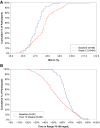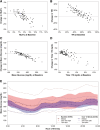The Insulin-Only Bionic Pancreas Pivotal Trial Extension Study: A Multi-Center Single-Arm Evaluation of the Insulin-Only Configuration of the Bionic Pancreas in Adults and Youth with Type 1 Diabetes
- PMID: 36173238
- PMCID: PMC9529297
- DOI: 10.1089/dia.2022.0341
The Insulin-Only Bionic Pancreas Pivotal Trial Extension Study: A Multi-Center Single-Arm Evaluation of the Insulin-Only Configuration of the Bionic Pancreas in Adults and Youth with Type 1 Diabetes
Abstract
Objective: To evaluate a transition from standard-of-care (SC) management of type 1 diabetes (any insulin delivery method including hybrid closed-loop systems plus real-time continuous glucose monitoring [CGM]) to use of the insulin-only configuration of the iLet® bionic pancreas (BP) in 90 adults and children (age 6-71 years). Research Design and Methods: After the SC group completed the randomized controlled trial (RCT) portion of the Insulin-Only BP Pivotal Trial, 90 of the 107 participants participated in a 13-week study using the BP. The key outcomes were change from baseline in HbA1c and CGM metrics after 13 weeks on the BP. Results: Using the BP, mean HbA1c decreased from 7.7% ± 1.0% (61 ± 10.9 mmol/mol) at baseline to 7.1% ± 0.6% (54 ± 6.6 mmol/mol) at 13 weeks (mean change -0.55% ± 0.72% [-6 ± 7.9 mmol/mol], P < 0.001), time in range 70-180 mg/dL increased by 12.0% ± 12.5% (from 53% ± 17% to 65% ± 9%, P < 0.001), and mean glucose decreased by -18 ± 23 mg/dL (from 182 ± 32 to 164 ± 15 mg/dL, P < 0.001). The higher the baseline HbA1c level, the greater the change in HbA1c. Results were similar in the adult (N = 42) and pediatric (N = 48) cohorts. Time <70 mg/dL decreased from baseline over the 13 weeks by -0.50% ± 1.86% (P = 0.02), and time <54 mg/dL was similar (change from baseline -0.08% ± 0.59%, P = 0.24). Two severe hypoglycemia events (in same participant) and one diabetic ketoacidosis event occurred. Conclusions: Glycemic control improved after adult and pediatric participants in the SC arm in the Insulin-Only BP Pivotal Trial transitioned to use of the BP. Improvement using the BP was of similar magnitude to that observed during the RCT. ClinicalTrials.gov number, NCT04200313.
Keywords: adults; artificial pancreas; automated insulin delivery; bionic pancreas; evaluation; pediatrics; type 1 diabetes.
Conflict of interest statement
J.L. has nothing to disclose. L.G.K., K.J.R., and P.C. have no personal financial disclosures but report that their employer has received grant support from Beta Bionics, Dexcom, and Tandem Diabetes Care. S.J.R. has a patent and patents pending on aspects of the bionic pancreas that are assigned to Massachusetts General Hospital and are licensed to Beta Bionics, has received honoraria and/or travel expenses for lectures from Novo Nordisk, Roche, and Ascensia, serves on the scientific advisory boards of Unomedical and Companion Medical, has received consulting fees from Beta Bionics, Novo Nordisk, Senseonics, and Flexion Therapeutics, has received grant support from Zealand Pharma, Novo Nordisk, and Beta Bionics, and has received in-kind support in the form of technical support and/or donation of materials from Zealand Pharma, Ascencia, Senseonics, Adocia, and Tandem Diabetes. ERD has issued patents and pending patents on aspects of the bionic pancreas, and is an employee, the Executive Chair of the Board of Directors, and shareholder of Beta Bionics. F.H.E.-K. has issued patents and pending patents on aspects of the bionic pancreas and is an employee and shareholder of Beta Bionics. C.B. reports receiving consulting payments from Beta Bionics, Novo Nordisk, and Zealand Pharma. R.W.B. reports no personal financial disclosures but reports that his institution has received funding on his behalf as follows: grant funding and study supplies from Tandem Diabetes Care, Beta Bionics, and Dexcom; study supplies from Medtronic, Ascencia, and Roche; consulting fees and study supplies from Eli Lilly and Novo Nordisk; and consulting fees from Insulet, Bigfoot Biomedical, vTv Therapeutics, and Diasome.
Figures



References
Publication types
MeSH terms
Substances
Associated data
Grants and funding
LinkOut - more resources
Full Text Sources
Medical

